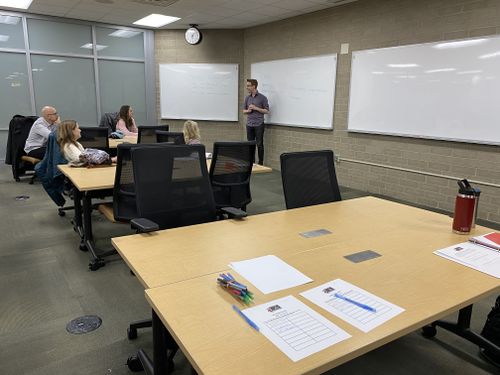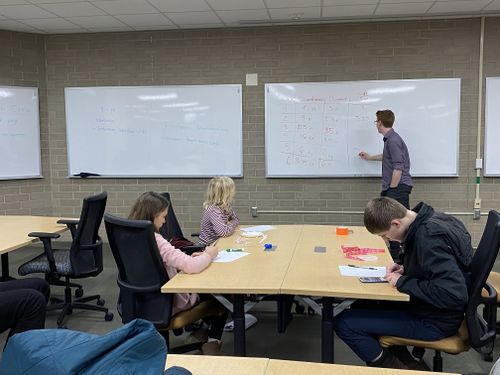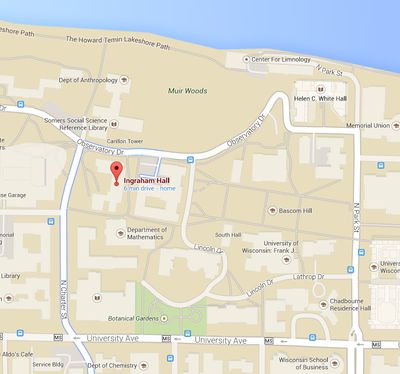Madison Math Circle
Weekly Meeting
We have a weekly meeting, Monday at 6pm in 120 Ingraham Hall, during the school year. New students are welcome at any point! There is no required registration, no fee, and the talks are independent of one another, so you can just show up any week. See below for directions.
If you are a student, we hope you will tell other interested students about these talks, and speak with your parents or with your teacher about organizing a car pool to the UW campus. If you are a parent or a teacher, we hope you'll tell your students about these talks and organize a car pool to the UW (all talks take place in Ingraham Hall room 120, on the UW-Madison campus).
What is a Math Circle?
The Madison Math Circle is a weekly series of mathematically based activities aimed at interested middle school and high school students. It is an outreach program organized by the UW Math Department. Our goal is to provide a taste of exciting ideas in math and science. In the past we've had talks about plasma and weather in outer space, video game graphics, and encryption. In the sessions, students (and parents) are often asked to explore problems on their own, with the presenter facilitating a discussion. The talks are independent of one another, so new students are welcome at any point.
The level of the audience varies quite widely, including a mix of middle school and high school students, and the speakers generally address this by considering subjects that will be interesting for a wide range of students.
After each talk we'll have pizza provided by the Mathematics Department, and students will have an opportunity to mingle and chat with the speaker and with other participants, to ask questions about some of the topics that have been discussed, and also about college, careers in science, etc.
The Madison Math circle was featured in Wisconsin State Journal: http://host.madison.com/wsj/news/local/education/local_schools/school-spotlight-madison-math-circle-gives-young-students-a-taste/article_77f5c042-0b3d-11e1-ba5f-001cc4c03286.html
All right, I want to come!
Directions and parking
Meetings are held in 120 Ingraham Hall.
Parking. Parking on campus is rather limited. Here is as list of some options:
- Directly in front of Ingraham hall, 2 metered spots (25 minute max) in Lot 11 off of Observatory Drive.
- A 0.2 mile walk to Ingraham Hall via these directions, many spots (free starting 4:30pm) in Lot 26 along Observatory Drive.
- A 0.3 mile walk to Ingraham Hall via these directions, many spots (free starting 4:30pm) in Lot 34.
- A 0.2 mile walk to Ingraham Hall via these directions, 2 metered spots (25 minute max) in front of Lathrop Hall.
- A 0.3 mile walk to Ingraham Hall via these directions 6 metered spots (25 minute max) around the loop in front of Chadbourne Hall .
- For more information, see the UW-Madison Parking Info website.
Email list
Sign up for our email list: https://lists.math.wisc.edu/listinfo/math-circle
Contact the organizers
If you have any questions, suggestions for topics, or so on, just email the organizers (Carolyn Abbott, Gheorghe Craciun, Daniel Erman, Lalit Jain, Ryan Julian, and Philip Matchett Wood): math-circle-organizers@math.wisc.edu. We are always interested in feedback!
Report on Math Circle in 2013-14
Flyer
Help us grow!
If you like Math Circle, please help us continue to grow! Students, parents, and teachers can help by:
- Posting our flyer at schools or anywhere that might have interested students
- Discussing the Math Circle with students, parents, teachers, administrators, and others
- Making an announcement about Math Circle at PTO meetings
- Donating to Math Circle
Contact the organizers if you have questions or your own ideas about how to help out.
Meetings for Fall 2014 and Spring 2015
All talks are at 6pm in Ingraham Hall room 120, unless otherwise noted.
| Fall 2014 | |||
|---|---|---|---|
| Date and RSVP links | Speaker | Topic | Link for more info |
| September 8, 2014 | Philip Matchett Wood | Pictures and Puzzles | |
| September 15, 2014 | Jen Beichman | Playing with geometric sums | |
| September 22, 2014 | DJ Bruce | Is any knot the unknot? | |
| September 29, 2014 | Uri Andrews | The games of Criss Cross and Brussels Sprouts | |
| October 6, 2014 | David Sondak | Fluids, Math, and Oobleck! | |
| October 13, 2014 | George Craciun | Proofs without words (but with plenty of pictures) | |
| October 20, 2014 | Scott Hottovy | Coming soon! | |
| October 27, 2014 | Daniel Hast | Clock arithmetic and perfect squares: a "Golden Theorem" of reciprocity | |
| November 3, 2014 | Alisha Zachariah | Infinity | |
| November 10, 2014 | Marko Budisic | Mathematics of epidemics | |
| November 17, 2014 | Nigel Boston | Same bad channel | |
| |
|||
| December 1, 2014 | Daniel Erman | How to catch a (data) thief | |
| Spring 2015 | |||
| TBA | Coming soon! | ||
| February 2, 2015 | Soledad Benguria | Exploring Palindromes | |
| February 9, 2015 | Jeff Linderoth | Coming soon! | |
| February 16, 2015 | Simon Marshall | Coming soon! | |
| February 23, 2015 | Uri Andrews | Coming soon! | |
| March 2, 2015 | Jordan Ellenberg | Coming soon! | |
| March 9, 2015 | Ali Gordon | Coming soon! | |
| March 23, 2015 | Betsy Stovall | Coming soon! | |
| March 30, 2015 | No meeting | UW Spring Break | |
| April 6, 2015 | Julie Mitchell | Coming soon! | |
| April 13, 2015 | Jessica Lin | Coming soon! | |
Abstracts
Philip Matchett Wood
Pictures and Puzzles
When does a simple picture solve a tricky puzzle? Come and learn about how line-and-dot drawing can solve complex puzzles, and create some new puzzles besides!
DJ Bruce
Is any knot the unknot?
Abstract: You're walking home from school, and you pull out your head phones to listen to some tunes. However, inevitably they are a horribly tangled mess, but are they really a knot? We'll talk about what exactly is a knot, and how we can tell when something is not the unknot.
David Sondak
Fluids, Math and Oobleck!
We will explore the magical world of fluids and their relationship to mathematics. As an example of fluids and math in the real world, we will make the living fluid oobleck and discuss some of its mathematical properties.
George Craciun
Proofs without words (but with plenty of pictures)
We will discuss mathematical proofs that can be done using only pictures or figures. If you want to see many such examples you can check out the book "Proofs without Words: Exercises in Visual Thinking" by Roger B. Nelsen. For more information also look at the wikipedia page http://en.wikipedia.org/wiki/Proof_without_words , where you can find links to Java Applets that show animations of proofs without words, such as http://usamts.org/Gallery/G_Gallery.php .
Daniel Hast
Clock arithmetic and perfect squares: a "Golden Theorem" of reciprocity
We'll explore systems of arithmetic where numbers loop back around to zero (like the hours on a clock!), called "modular arithmetic". Which numbers are perfect squares in such systems? Gauss, one of the greatest mathematicians in history, called the remarkable answer the "golden theorem".
Alisha Zachariah
What is infinity anyway
Infinity has a long history of having confounded and fascinated thinkers. We will take a look at some fundamental problems that early mathematicians grappled with and see some ways to understand infinity that have contributed to how we do math today.
Marko Budisic
Mathematics of epidemics
Infectious diseases in our communities often make it into daily conversation: "There's a nasty cold going around.", "It's the flu season, get your shots.", and even, "There are news of a zombie outbreak!" Come hear how math gets applied to something as messy as spread of disease. We will use our wits, pencils, and computers to understand the progress of headaches, common cold, zombie outbreaks, and even ebola, a disease that is currently making the news.
Nigel Boston
Same bad channel
How do we get such clear photos of the comet in the news? A 20 watt transmitter sends signals 500 million km through space to us and yet amazingly they survive this ordeal error-free. What's behind this is error-correcting codes. I'll give some of the basics, some related puzzles, and some challenges.
Soledad Benguria
Exploring Palindromes
A Palindrome is a word or a number that reads the same forward and backwards. For example, Hannah, radar and civic are palindromic words, and 34743, 6446 are palindromic numbers. We will explore some curious properties of palindromes, and talk about what makes the number 196 special.
Archived Math Circle Material
Link for presenters (in progress)
[[1]]


